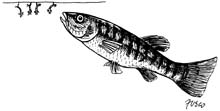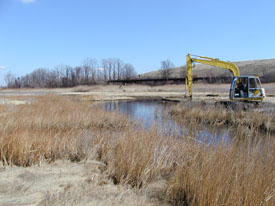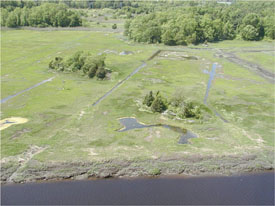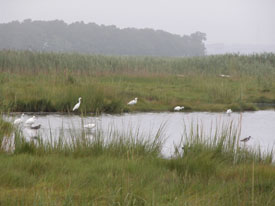Mosquito Control Using Water Management
Where environmentally feasible, the Wetland Habitat and Mosquito Management (WHAMM) Program uses water management for source reduction and biological control of mosquitoes by making the sites 1) unsuitable for mosquito egg and larval development and 2) enhancing the area to provide open water habitat for natural mosquito predators, such as fish and birds. Water management provides more permanent control of mosquitoes than insecticides, resulting in a substantial reduction in insecticide applications and costs.
In tidal saltmarshes, a technique known as Open Marsh Water Management (OMWM) is the preferred method for controlling mosquitoes and enhancing or restoring wetland habitat (more about OMWM). Unlike the parallel grid-ditch method used in the 1930s, which had adverse effects on tidal wetland hydrology and habitat, OMWM involves the selective excavation of shallow pools and ditches in mosquito-breeding areas. These pool and ditch networks are not connected directly to tidal channels and, therefore, do not drain at low tide. A higher water level is maintained in the pools, which provides habitat for fish and other wildlife and encourages revegetation of the surrounding marsh by native grasses. Mosquito management is achieved by modifying egg-laying sites and creating open water habitat for small, naturally-abundant killifish, which prey on mosquito larvae and pupae. OMWM systems provide long-term control of mosquitoes, thus reducing the need to apply insecticides.

Low ground pressure equipment excavates shallow pools and channels on the marsh surface to control mosquitoes and provide wildlife habitat.

Shallow pools and plugged ditches restore wildlife habitat and control mosquitoes.

Open marsh water management creates and restores habitat for fish, invertebrates, shorebirds, wading birds, and waterfowl.
Mosquito Myths
A number of products on the market claim to have mosquito control capabilities. In most cases, these products have not been rigorously tested and do not perform as advertised. Mechanical traps, such as ultraviolet “bug zappers” or devices that repel using ultrasonic sound waves, do not meet advertiser’s claims. In fact, bug zappers attract few mosquitoes and may actually kill beneficial insect predators. The Connecticut Mosquito Management Program, along with other states and the American Mosquito Control Association, does not endorse the use of these products to reduce mosquito infestations. Natural products, such as citronella-scented candles and plants, clove oil, peppermint, or diet supplements like garlic or vitamins, that claim to repel mosquitoes are not supported by scientific evidence. Many individuals may believe these products are effective; however, each person has a unique metabolism and body chemistry and the products may not be equally effective for everyone.
Natural predators, such as bats and some birds, will eat adult mosquitoes, as do other types of insects, such as dragonflies. However, studies have shown that mosquitoes make up a very small percentage of a bat or bird's diet. Bats and insectivorous birds are opportunistic feeders and may consume a large number of mosquitoes if mosquito populations are very high. However, if adult mosquitoes are at moderate or low levels (but yet are at pestiferous levels or in numbers that could still effectively transmit disease), bats or birds will not expend the energy to chase enough mosquitoes to obtain the equivalent amount of food as say a moth or large beetle. The CT Mosquito Management Program encourages the placement of bat and birdhouses for the conservation of these species but does not endorse the use of them solely for the control of mosquitoes. For further information on mosquito myths, visit the University of Florida's Mosquito Information Website.
Content last updated in September 2024.

